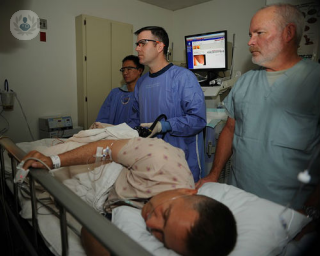Rectal prolapse is when the end of the large intestine (rectum) out through the anus. The externalization of the rectum may be only the mucosa, the entire wall or consist of a descent through the year without going outside. Rectal prolapse may be caused by the weakness of the tissues that support the rectum, constant efforts when to evacuate, constipation, aging or genetic causes. The most common symptom is a red lump or mass on the year, usually after a deposition. There may also be bleeding, mucus, involuntary leakage of gas or fecal incontinence. Rectal prolapse can be treated effectively with surgery, removing a portion of the intestine (perineal rectosigmoidectomy) or suturing the rectum to the surrounding tissue. You can also place a piece of synthetic mesh around the rectum so that it stays in place (rectopexy).
Rectal prolapse
Rectal prolapse is when the end of the large intestine (rectum) out through the anus. The externalization of the rectum may be only the mucosa, the entire wall or consist of a descent through the year without going outside. Rectal prolapse may be caused by the weakness of the tissues that support the rectum, constant efforts when to evacuate, constipation, aging or genetic causes. The most common symptom is a red lump or mass on the year, usually after a deposition. There may also be bleeding, mucus, involuntary leakage of gas or fecal incontinence. Rectal prolapse can be treated effectively with surgery, removing a portion of the intestine (perineal rectosigmoidectomy) or suturing the rectum to the surrounding tissue. You can also place a piece of synthetic mesh around the rectum so that it stays in place (rectopexy).


Advances in colorectal surgery
By Dr. Lorenzo Viso Pons
2024-04-26
Dr Pons Viso is a premier proctologo extensive experience in the treatment of anal diseases. This video explains that progress has been made in this general area in recent years. See more


rectal prolapse: how to identify it?
By Dr. Francisco Javier Aramburu Maqua
2024-04-26
Dr. Aramburu explains what rectal prolapse, the factors favoring its appearance, if there is any way to prevent it, what its symptoms and treatment options are. See more


rectal prolapse
By Dr. Doménico Fraccalvieri
2024-04-26
Rectal prolapse is the output of the final part of instestino thick throughout the year. The amount of intestine prolapses depends on the severity of the disease. The main cause is constipation and the only treatment surgery. See more


Meet minimally invasive surgery for hemorrhoids
By Dr. Juan José Arenal Vera
2024-04-25
What are hemorrhoids? What is your surgery? Knows all the details of your treatment thanks to the specialist in General Surgery, Dr. Arenal Vera. See more
Experts in Rectal prolapse
-
Dr. Javier De Oca Burguete
Colon & Rectal SurgeryExpert in:
- Anal fistula surgery
- Rectal prolapse
- Crohn disease
- Colitis
- Colorectal cancer surgery
-
Dr. Lorenzo Viso Pons
Colon & Rectal SurgeryExpert in:
- Anal fistula surgery
- Rectal surgery
- Colorectal cancer surgery
- Hemorrhoid Surgery
- Rectal prolapse
- Sacral cyst surgery
-
Dr. Doménico Fraccalvieri
Colon & Rectal SurgeryExpert in:
- Hemorrhoid Surgery
- Pelvic floor reconstructive surgery
- Fistula
- Anal Fissure
- Anal Incontinence
- Rectal prolapse
-
Dr. Francisco Javier Aramburu Maqua
Colon & Rectal SurgeryExpert in:
- Colorectal cancer surgery
- Anal laser surgery
- Anal Fissure
- Rectal prolapse
-
Dr. Francisco Javier Aramburu Maqua
SurgeryExpert in:
- Colon cancer
- Colorectal cancer surgery
- Anal Fissure
- Anal Incontinence
- Rectal prolapse
- See all

Hospital Quirónsalud Barcelona
Hospital Quirónsalud Barcelona
Plaza Alfonso Comín, 5
No existe teléfono en el centro.
By using the telephone number provided by TOP DOCTORS, you automatically agree to let us use your phone number for statistical and commercial purposes. For further information, read our Privacy Policy
Top Doctors

Asistencia Quirúrgica - Servicio de Cirugía General y Digestiva HM Delfos
Asistencia Quirúrgica - Servicio de Cirugía General y Digestiva HM Delfos
Avinguda de Vallcarca, 151, planta -1, despacho 34 (Servicio de Cirugía)
No existe teléfono en el centro.
By using the telephone number provided by TOP DOCTORS, you automatically agree to let us use your phone number for statistical and commercial purposes. For further information, read our Privacy Policy
Top Doctors

IQL - Instituto Quirúrgico Lacy
IQL - Instituto Quirúrgico Lacy
Plaza Alfonso Comín, 5-7, 2ª planta
No existe teléfono en el centro.
By using the telephone number provided by TOP DOCTORS, you automatically agree to let us use your phone number for statistical and commercial purposes. For further information, read our Privacy Policy
Top Doctors
-
Hospital Quirónsalud Barcelona
Plaza Alfonso Comín, 5, BarcelonaExpert in:
- Vascular Surgery
- Digestive
- Medical Oncology
- Assisted Reproduction
- Trauma
-
Asistencia Quirúrgica - Servicio de Cirugía General y Digestiva HM Delfos
Avinguda de Vallcarca, 151, planta -1, despacho 34 (Servicio de Cirugía), BarcelonaExpert in:
- Digestive
- Bariatric Surgery
- Obesity Surgery
- Endocrine Surgery
- Surgical Oncology
- Colorectal
-
IQL - Instituto Quirúrgico Lacy
Plaza Alfonso Comín, 5-7, 2ª planta, BarcelonaExpert in:
- Digestive
- Children's Digestive System
- Cancer
- Bariatric Surgery
- Obesity Surgery
- General Surgery
- See all
- Most viewed diseases, medical tests, and treatments
- Second medical opinion
- anorectal manometry
- Anal Incontinence
- Anal Fissure
- Inflammatory bowel disease
- Crohn disease
- Ulcerative colitis
- Colitis
- Gastric reflux
- Ph-metry







